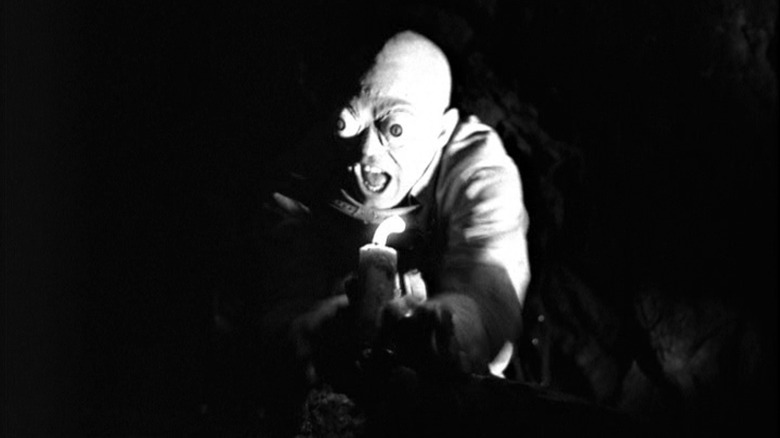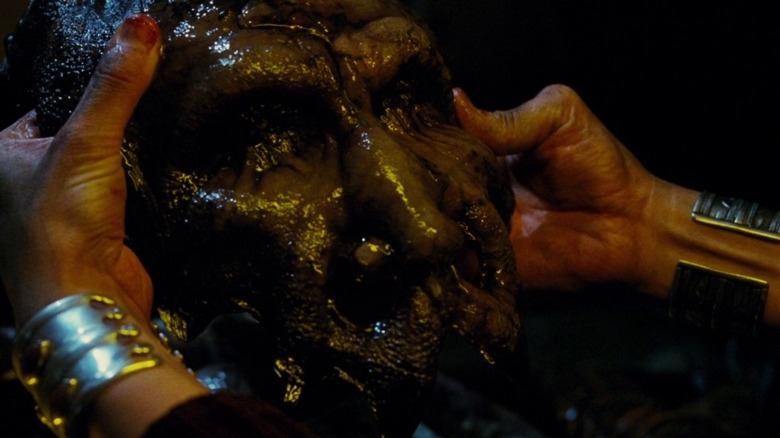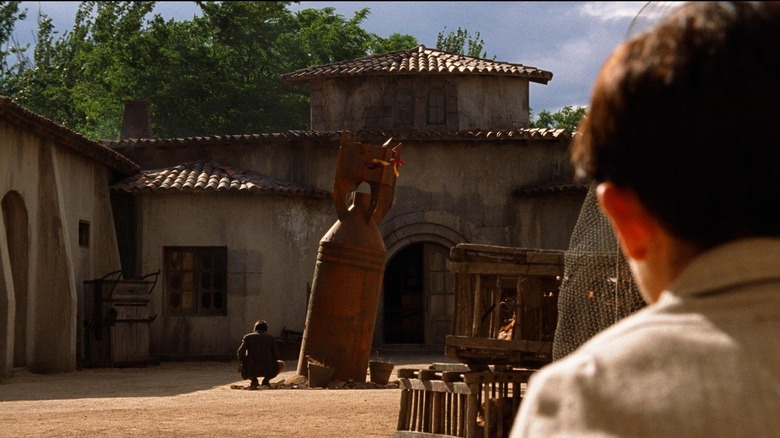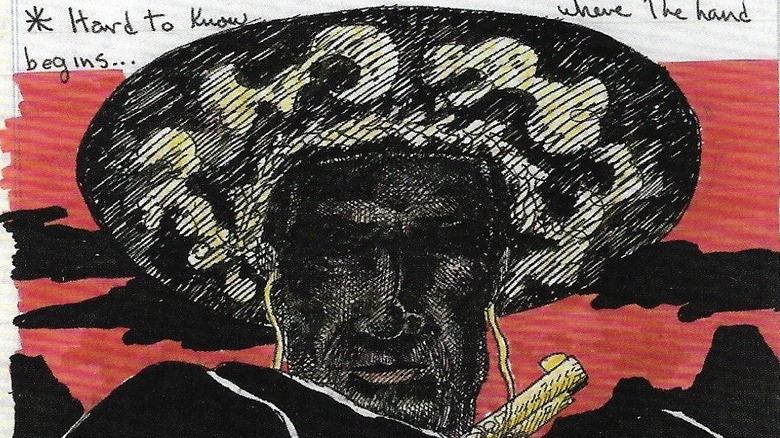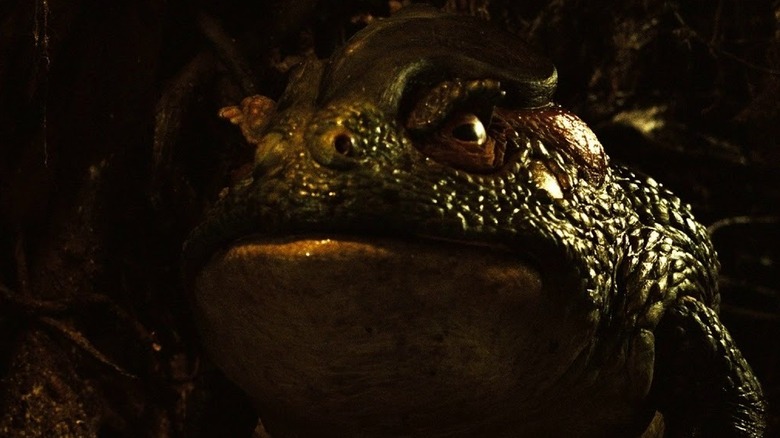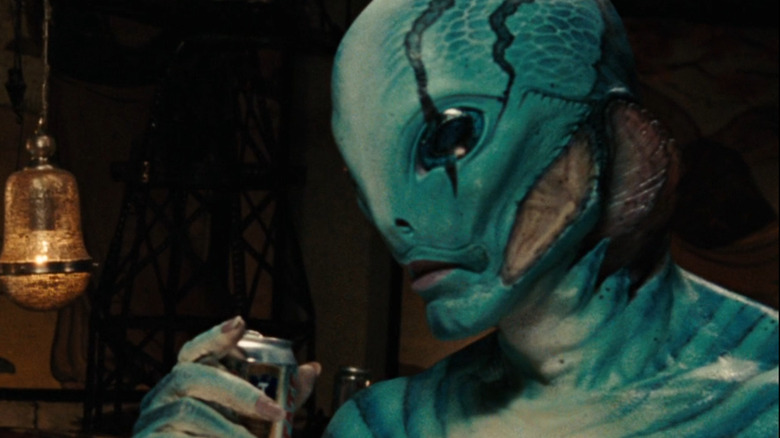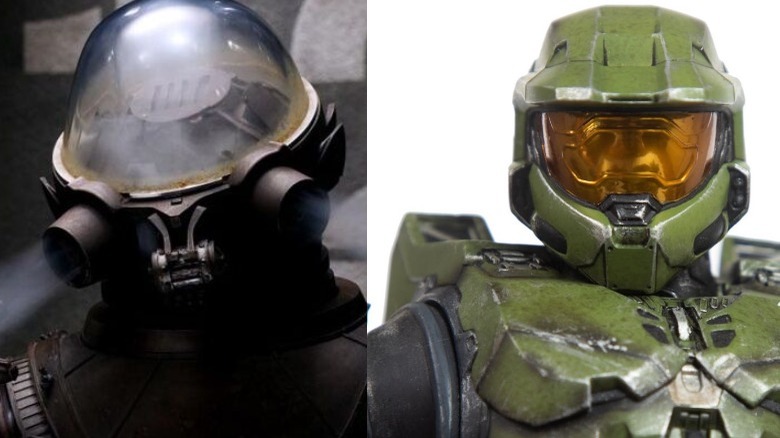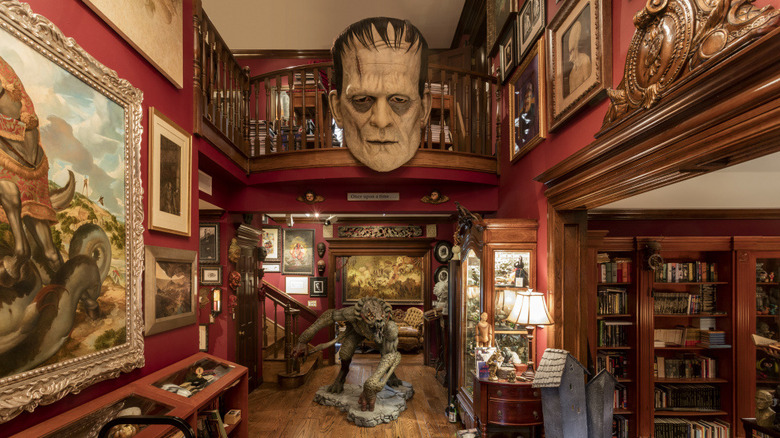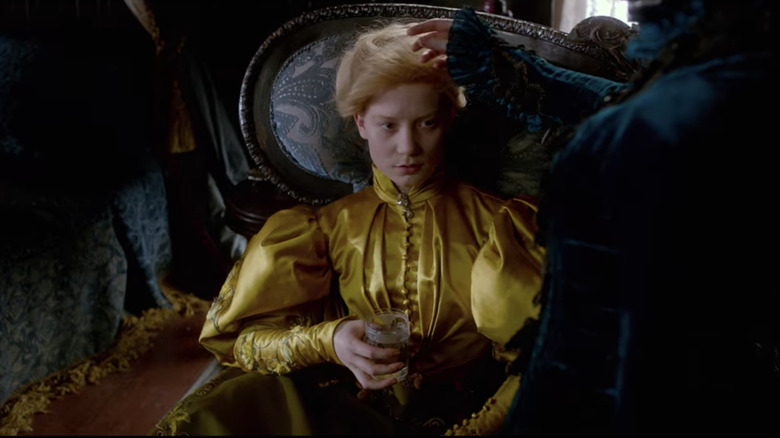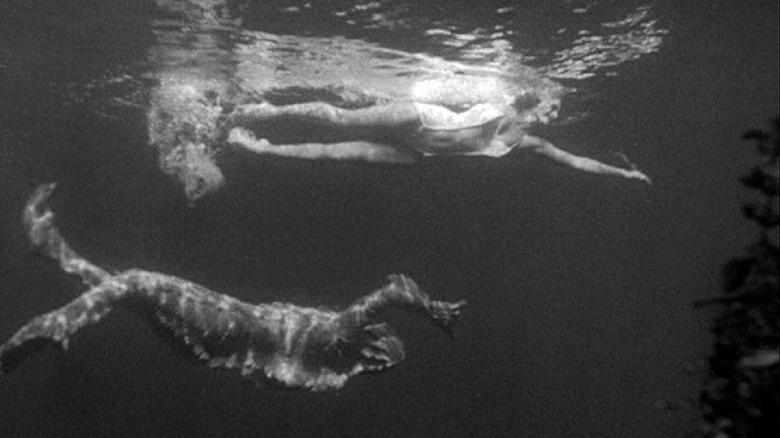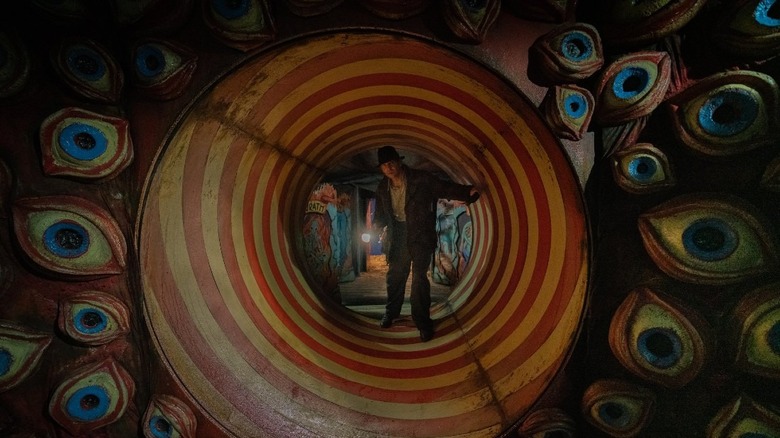The Untold Truth Of Guillermo Del Toro
As genre filmmaking becomes more and more brand-oriented, with the personality of a franchise or studio overwhelming any of the individual artists involved, Guillermo del Toro stands out as one of the last true auteurs in this side of Hollywood. The Mexican-born director has developed an extensive library of personal tics and obsessions that would make contemporaries like Wes Anderson or Tim Burton blush, and he's evolved them into something deeper than that. They tie his entire life and career across film, television, and novels – even the ones he never finished – into a single work, with each piece, even the weakest ones, adding up to a greater whole.
In "Cabinet of Curiosities: My Notebooks, Collections, and Other Obsessions," he says, "You write a single book and you make a single movie ... the reality is you graft them all together. ... Renoir, the painter, he put it very nicely. He said, 'A painter paints the same tree all of his life.'" By assimilating everything from the pulpiest horror schlock to the most obscure and academic details of art history and biology, del Toro has continued working on that single movie, all the way from his microbudget Mexican debut "Cronos" to his all-star film noir "Nightmare Alley." It's a long process stretching across his art and life, and here are just a few of the strangest steps along the way.
He owes his career to a childhood pact with monsters
Guillermo del Toro rose to the Hollywood A-list with his adaptations of the comic book heroes Blade and Hellboy, and he loves the medium so much he's devoted an entire room of his house to his comic book library. So it's fitting that, just like the best superheroes, he has a colorful origin story.
In his BFI Screen Talk, del Toro recalls his childhood in Guadalajara, Mexico. He and his brother had stayed up late watching the classic science fiction anthology series "The Outer Limits" and got a brutal reminder of why they were supposed to be in bed when the 2-year-old del Toro saw a big-headed, bug-eyed monster. "I started screaming, and I couldn't stop. And my brother was a bit of an a******," del Toro said, noting that his brother had the "great idea" to dress up as the TV monster and stick his head into Guillermo's crib.
This kicked off weeks of intense nightmares where del Toro was surrounded by monsters and the accompanying bedwetting when he was too scared to leave the crib. Even the shag carpeting turned into "a sea of fingers" reaching out to grab him. Finally, he decided to talk it out with the monsters: "If you let me go to the bathroom, I'll be your friend forever." It's hard to imagine that toddler knew that pact would last for the rest of his life and lead him to a career as the monsters' greatest living ambassador.
His first notebook is somewhere in James Cameron's house
Guillermo del Toro's filmmaking is just one piece of the conception of his entire life as a single work of art. To complete the picture, you've also got to consider his collection of pocket-sized leather-bound notebooks, much like the one master magician Zeena gives to Stan Carlisle in "Nightmare Alley." They're all masterpieces in their own right, full of strange images, philosophical musings, and some ideas that eventually come to life on screen. Others are as mysterious and evocative as a dream journal.
But it seems that the collection will always be missing an essential piece. In "Cabinet of Curiosities," del Toro explains why he has so few notes from his first feature, "Cronos." The post-production was, in his words, "a very dire time ... the day I took a shower, I couldn't eat lunch." Still, it wasn't all bad news since del Toro got a lunch meeting with no less a Hollywood mover-and-shaker than "Titanic" and "Terminator" director James Cameron. Del Toro took advantage of the opportunity to load up on enough food for the rest of the week while the waiter kept offering him wine until he got sloppy, sappy drunk and gifted Cameron his notebook. "The end of the story is that the notebook — he says he has placed it somewhere," del Toro said. "He still lives in the same house, so I have hopes, but he hasn't been able to find it since."
He hated working with the Weinsteins
The Weinstein Brothers have become some of the most infamous figures in the film industry after many allegations of sexual predation against Harvey. But even before the extent of his crimes was widely known, they still earned deep resentment from their collaborators for their extensive meddling. And Guillermo del Toro had the misfortune of taking them as his introduction to Hollywood with his first American film, "Mimic."
Del Toro's life was already difficult enough at the time: He told BFI, "I can tell you, two horrible things happened in the late '90s. My father was kidnapped, and I worked with the Weinsteins. And I don't know which one was worse. Actually, the kidnapping made more sense. Because I knew what they wanted, you know?"
He goes into more detail in "Cabinet of Curiosities." Trouble started from day one when del Toro shot what he thought was an incredibly beautiful image only for the producers to complain, "Are you making an art film out of a B-movie bug picture?" In the end, they took "Mimic" out of del Toro's hands entirely, bringing in a new director to add extra material, including a new ending. Where del Toro wanted to end with a shocking moment revealing how human the insectoid "Mimic" had become, telling the protagonist, "Go. Leave," the final cut "ended up having an explosion rather than an explosion of ideas."
Del Toro lost the Devil's Backbone for years
After his disastrous experience on "Mimic," Guillermo del Toro was so disillusioned with the American studio system that it seemed his career would end just as it began. Then he found new inspiration on a new continent with the help of another maverick filmmaker. "Pedro Almodóvar resurrected me from the dead after 'Mimic,'" del Toro writes in "Cabinet of Curiosities." Their collaboration was del Toro's third movie, but it had nearly been his first.
Del Toro writes glowingly of his eccentric screenwriting teacher, Jaime Humberto, who taught him the importance of revision by insisting students write all their rough drafts on pink paper. That might just seem whimsical, but with the black-and-white photocopying technology of the time, the pink sheets would come out blank, forcing students to type out their scripts all over again. "And if you are able to type it again and not change anything, that means it's really, really good," Humberto said.
But Humberto's perfectionism had its downsides. When del Toro turned in his first script for "The Devil's Backbone," Humberto flipped through it and immediately tossed it in the trash. "It's badly formatted," he said. "If you cannot take the trouble to write it well, why should anyone take the trouble to read it well?" Instead of trying to rewrite the whole thing from memory, del Toro started over and eventually created "Cronos."
His favorite screenplay is one he never filmed
Following Guillermo del Toro's career can inspire a mix of fascination and frustration. The number of movies he might have made exponentially outnumbers the ones he has, whether they're hired-gun projects that would have let us see his unique vision applied to existing worlds — like "Harry Potter," Middle-earth, or the DC and Marvel universes — or personal projects that fell by the wayside. You might blame this on perfectionism or simple disinterest, but in at least one case, that couldn't be further from the truth. In "Cabinet of Curiosities," del Toro says his best script is one he never filmed and probably never will.
"The Left Hand of Darkness" was deeply personal to the director, who used his second draft to channel all his rage and grief over his father's kidnapping into Alexandre Dumas' classic revenge tale "The Count of Monte Cristo." This wouldn't have been a straightforward adaptation, though. Del Toro reimagined the story as a Western and reinvented Dumas' hero Edmond Dantèsas a steampunk cyborg, a true monster in the classic del Toro tradition. "In the book, the Count is often mentioned as a 'pirate,' a 'vampire,' a 'thief,'" del Toro told Ain't It Cool News. "He's very dark. And in my adaptation, the Count only goes out at nights. He's very close to a Dracula coming from a Western, all dressed in black, red, and gold."
He dropped out of The Wind in the Willows after a suggestion from Disney
Some of Guillermo Del Toro's lost films, like "The Hobbit" or "At the Mountains of Madness," only collapsed after years in production. Others he had no trouble saying goodbye to. The pages from the director's "Hellboy" notebooks in "Cabinet of Curiosities" are full of intriguing references to the timeless world of Kenneth Grahame's turn-of-the-century children's classic "The Wind in the Willows": "The trees move so that people can't get in, and the animals greet each other with 'may man avoid you' or may man ignore you' ... The Beaver [?] (the human 'boat') in the gigantic [?] and, in order to save himself, he must abandon his 'human' body. ... Toad and Beaver become very good friends, and at the end, they're seen flying together in an enormous dirigible that they built together."
Unfortunately, "timeless" wasn't exactly what Disney had in mind when they called up del Toro about the project. Del Toro told Rotten Tomatoes, "It was a beautiful book, and then I went to meet with the executives, and they said, 'Could you give Toad a skateboard and make him say, 'radical dude' things,' and that's when I said, 'It's been a pleasure...'" We can't be sure he literally left right then and there, but we sure like to think so.
Abe Sapien's creator bribed him not to change his design
Adapting Mike Mignola's supernatural adventure comic "Hellboy" meant the two artists worked closely together, leading to an intimate relationship, but not one without its rough patches. One of their biggest challenges was adapting Hellboy's mysterious amphibian sidekick Abe Sapien to live-action. "Cabinet of Curiosities" is full of sketches of alternate Abes hiding the expensive facial effects under elaborate water-breathing helmets or goggles. One design for the face itself was a bridge (or several) too far for Mignola when del Toro experimented with giving Abe a wide, fishlike mouth. "He was so horrified by the idea of the mouth that he said to me, 'If you don't do that, I'll give you four pages of any of my stories you like,'" del Toro recounted. "And I have the four pages upstairs. I'm a cheap man."
This wouldn't be the last time Mignola would lord over del Toro with original comics art. Among their common interests is the great Marvel architect and all-around mad genius Jack Kirby. One Kirby story in particular — from his DC series "The Demon" — riffed on "The Phantom of the Opera" as "The Phantom of the Sewers," building to a full-page image of the unmasked monster screaming, "He took my face! He took my face!" It made such an impression on young del Toro that he copied and recopied it endlessly. "The original art, which I always wanted to buy, is in the hands of Mike Mignola, and he constantly tortures me with that fact," the director said.
Del Toro never lets an idea go to waste
Guillermo del Toro tweeted that his unproduced scripts represent "more than a decade of work lost" since "each script takes about a year." But looking through his notebooks, you realize that work is never entirely lost. "Hellboy 2" especially became a haven for orphaned ideas. The Angel of Death's wing-covered eyes were inspired by del Toro's love of the 19th-century Symbolist art movement and previously appeared in designs for the demonic namesake of Christopher Fowler's horror novel "Spanky." On the audio commentary, del Toro reveals the insectoid mouthpiece on the spectral agent Krauss' containment suit originated from a design for Master Chief in a mooted "Halo" movie. He also points out two Old Ones from his decades-in-progress adaptation of H.P. Lovecraft's cosmic horror classic "At the Mountains of Madness" in the crowd at the Troll Market.
Speaking of long productions, del Toro's two years in New Zealand on "The Hobbit" don't seem to have totally gone to waste. One design he commissioned for the dragon Smaug — with the pyramidal horns on his nose and the electric-blue gloop dropping from his jaws — could be a cousin to Otachi, one of the monsters in del Toro's next film, "Pacific Rim." Even the titular "Left Hand of Darkness" wasn't lost forever, with its exposed-gear design reappearing on the body-modding Nazi Kroenen in "Hellboy." His explanation for that choice describes his whole creative process: "It's a matter of 'I want that image.' I don't care where it comes from."
His house is a living museum
Above all else, Guillermo del Toro is a monster kid all grown up, the rare one who actually got to live out all his childhood dreams. But it's hard to imagine even those dreams living up to the reality of the living museum nicknamed Bleak House. A library of nothing but comics or horror? Bleak House has got it. A room devoted to Disneyland's Haunted Mansion? Bleak House has got it. A room where it's always raining? Bleak House has that too.
Impressively, the project got so huge that del Toro had to buy out his neighbor's house to contain it all. But while this expensive collection shows his ascension to the lifestyles of the rich and famous, del Toro never forgets where he came from. When the Los Angeles Times toured the house, del Toro asked, "Do you want to see my first werewolf?" and showed off an early attempt cannibalized from his grandmother's faux-fur coat. And despite a near-miss in the California wildfires of 2018, Bleak House is still open to wow any lucky guests.
He changed the size of the props in Crimson Peak
Guillermo del Toro's films are so full of strange and intricate details and sumptuous color that it would be tempting to call them "eye candy." But he prefers to think of it as "eye protein." In other words, all those pretty pictures (or just as often, the exact opposite) aren't there just to look at — every visual choice serves the story, whether as color symbolism, foreshadowing, or subliminal storytelling.
Del Toro offers a classic example in his audio commentary for "Crimson Peak." This take on the Gothic romance stars Mia Wasikowska as Edith Cushing, an aspiring inventor who seems to have found the man of her dreams with Tom Hiddleston's Sir Thomas Sharpe. But things take a turn in the titular family home, which is haunted by the ghosts of previous wives, and Edith might be next as she's slowly poisoned to death. In his audio commentary, del Toro explains how he was able to show Edith weakening through subliminal shorthand. He built all the furniture in "Crimson Peak" twice, once at life-size and once 30% larger to make Edith seem smaller and frailer. If you didn't notice, don't feel bad — you were never supposed to. But if you still caught the vague feeling of diminishment, then you know del Toro did his job.
A childhood misunderstanding inspired The Shape of Water
Ever since he made that pact in his crib, Guillermo del Toro has sided with movie monsters over their supposedly heroic human antagonists, and one story from his BFI interview shows just how deep that identification goes. The first time he saw the '50s classic "The Creature from the Black Lagoon," he recalls watching the creature and the heroine: "I was just a kid and didn't know better, and I thought, 'Oh gee, I hope they end up together.' And they didn't. I thought it was a completely unfair movie, because it's basically a home invasion. You have this creature living peacefully in this river ... and you go, 'This poor b****** was in his slippers having a good time at home' ... and I thought I would rectify that."
That process began almost immediately — del Toro told the Hollywood Reporter he would doodle the creature and heroine's romantic bliss, "eating ice cream, on a double bicycle, having dinner." He pitched his idea to the creature's caretakers at Universal and — proving that just because you have a job doesn't mean you know how to do it — they turned him down. But del Toro got the last laugh when he and actor Doug Jones created a new version of the iconic monster in "The Shape of Water" and spun his love story with a mute janitor played by Sally Hawkins into Oscar gold: thirteen nominations and four wins, including Best Picture and Director.
Del Toro filled the Nightmare Alley set with real antiques
While it's missing the explicitly supernatural elements of most of Guillermo del Toro's films, the world of traveling carnivals and WWII-era high society in "Nightmare Alley" is just as magical and sumptuous as anything else he brought to the screen. That proved to be a challenge for multiple reasons, over and above the production's delay by the 2020 COVID-19 pandemic and the safety restrictions it had to follow once it started up again.
Del Toro has stayed away from big Hollywood budgets outside of "Pacific Rim," his ill-fated attempts at "The Hobbit," and "At the Mountains of Madness," and "Nightmare Alley" is no exception. Fortunately, as the state of his house would suggest, del Toro is an avid collector. In fact, he told Jimmy Kimmel he has been an active eBay user since the site launched, and he was able to provide the necessary vintage materials out of pocket. He also told Collider he scoured eBay for genuine antiques to bring to the set, from the light fixtures to the carnival prizes all the way down to popcorn bags and balloons. He even bought vintage dollar bills because he wanted to make sure they not only looked period-appropriate but also like they'd really been in and out of multiple pockets.

